Comprehensive Spatial-Temporal and Risk Factor Insights for Optimizing Livestock Anthrax Vaccination Strategies in Karnataka, India
Abstract
1. Introduction
2. Materials and Methods
2.1. Study Area
2.2. Data Source
2.2.1. Anthrax Incidence Data
2.2.2. Pseudo-Absence Data
2.2.3. Livestock Population Data
2.3. Risk Factors
2.3.1. Meteorological Data
2.3.2. Remote Sensing Data
2.3.3. Soil Profile Data
2.3.4. Geographical Parameters
2.4. Data Pre-Processing and Feature Engineering
2.5. Spatial and Temporal Distribution of Anthrax Incidence
2.6. Spatial Autocorrelation-Hotspot Analysis
2.7. Space-Time Cluster Analysis
2.8. Linear Discriminant Analysis
2.9. Modelling Anthrax Niches through Machine Learning
2.10. Model Evaluation Criterion
2.11. Ensemble Modelling Approach for Better Accuracy
2.12. Basic Reproduction Number Estimation to Understand Anthrax Transmission Dynamics
2.12.1. Attack Rate Estimate (AR)
2.12.2. Exponential Growth Rate (EG)
2.12.3. Maximum Likelihood (ML) Estimate
2.13. Estimation of Herd Immunity Threshold (HIT)
2.14. Determination of Vaccine Coverage (Vc)
2.15. Vaccination Supply and Demand Status in Karnataka
2.16. Statistical Analysis and Packages
3. Results
3.1. Spatial Distribution of Anthrax
3.2. Temporal Distribution of Anthrax
3.3. Spatial Autocorrelation Hotspot Analysis
3.4. Analysis of Space-Time Cluster
3.5. Significant Risk Factors Identified through LDA
3.6. Anthrax Risk Assessment and Estimation through Machine Learning
3.7. Transmission Dynamics
3.8. Herd Immunity Threshold
3.9. Vaccination Coverage
3.10. The Vaccine Supply and Demand Trend in Karnataka
4. Discussion
5. Conclusions
Supplementary Materials
Author Contributions
Funding
Institutional Review Board Statement
Informed Consent Statement
Data Availability Statement
Acknowledgments
Conflicts of Interest
References
- Pittiglio, C.; Shadomy, S.; El Idrissi, A.; Soumare, B.; Lubroth, J.; Makonnen, Y. Seasonality and Ecological Suitability Modelling for Anthrax (Bacillus anthracis) in Western Africa. Animals 2022, 12, 1146. [Google Scholar] [CrossRef] [PubMed]
- Zorigt, T.; Ito, S.; Isoda, N.; Furuta, Y.; Shawa, M.; Norov, N.; Lkham, B.; Enkhtuya, J.; Higashi, H. Risk Factors and Spatio-Temporal Patterns of Livestock Anthrax in Khuvsgul Province, Mongolia. PLoS ONE 2021, 16, e0260299. [Google Scholar] [CrossRef] [PubMed]
- Hugh-Jones, M.E.; de Vos, V. Anthrax and Wildlife. Rev. Sci. Tech. 2002, 21, 359–383. [Google Scholar] [CrossRef] [PubMed]
- Kaufmann, A.F.; Dannenberg, A.L. Age as a Risk Factor for Cutaneous Human Anthrax: Evidence from Haiti, 1973–1974. Emerg. Infect. Dis. 2002, 8, 874–875. [Google Scholar] [CrossRef] [PubMed]
- Carlson, C.J.; Kracalik, I.T.; Ross, N.; Alexander, K.A.; Hugh-Jones, M.E.; Fegan, M.; Elkin, B.T.; Epp, T.; Shury, T.K.; Zhang, W.; et al. The Global Distribution of Bacillus anthracis and Associated Anthrax Risk to Humans, Livestock and Wildlife. Nat. Microbiol. 2019, 4, 1337–1343. [Google Scholar] [CrossRef]
- Ahmed, B.-N.; Sultana, Y.; Fatema, D.S.M.; Ara, K.; Begum, N.; Mostanzid, S.M.; Jubayer, S. Anthrax: An Emerging Zoonotic Disease in Bangladesh. Bangladesh J. Med. Microbiol. 2010, 4, 46–50. [Google Scholar] [CrossRef]
- Tan, L.M.; Hung, D.N.; My, D.T.; Walker, M.A.; Ha, H.T.T.; Thai, P.Q.; Hung, T.T.M.; Blackburn, J.K. Spatial Analysis of Human and Livestock Anthrax in Dien Bien Province, Vietnam (2010–2019) and the Significance of Anthrax Vaccination in Livestock. PLoS Neglected Trop. Dis. 2022, 16, e0010942. [Google Scholar] [CrossRef]
- Chanda, M.M.; Prajapati, A.; Yogisharadhya, R.; Umesh, L.; Palegar, M.S.; Hemadri, D.; Shome, B.R.; Shivachandra, S.B. Elevation Determines the Spatial Risk of Anthrax Outbreaks in Karnataka, India. Acta Trop. 2023, 240, 106848. [Google Scholar] [CrossRef]
- Durrheim, D.N.; Freeman, P.; Roth, I.; Hornitzky, M. Epidemiologic Questions from Anthrax Outbreak, Hunter Valley, Australia. Emerg. Infect. Dis. 2009, 15, 840–842. [Google Scholar] [CrossRef]
- Mongoh, M.N.; Dyer, N.W.; Stoltenow, C.L.; Khaitsa, M.L. Risk Factors Associated with Anthrax Outbreak in Animals in North Dakota, 2005: A Retrospective Case-Control Study. Public Health Rep. 2008, 123, 352–359. [Google Scholar] [CrossRef]
- Kozytska, T.; Bassiouny, M.; Chechet, O.; Ordynska, D.; Galante, D.; Neubauer, H.; Wareth, G. Retrospective Analysis of Official Data on Anthrax in Europe with a Special Reference to Ukraine. Microorganisms 2023, 11, 1294. [Google Scholar] [CrossRef] [PubMed]
- Railean, V.; Sobolewski, J.; Jaśkowski, J.M. Anthrax in One Health in Southern and Southeastern Europe—The Effect of Climate Change? Vet. Res. Commun. 2024, 48, 623–632. [Google Scholar] [CrossRef] [PubMed]
- John, L.; Shekede, M.D.; Gwitira, I.; Mazhindu, A.N.; Pfukenyi, D.M.; Chikerema, S. Modelling Climate Change Impacts on the Spatial Distribution of Anthrax in Zimbabwe. BMC Public Health 2024, 24, 632. [Google Scholar] [CrossRef]
- Goel, A.K. Anthrax: A Disease of Biowarfare and Public Health Importance. World J. Clin. Cases 2015, 3, 20–33. [Google Scholar] [CrossRef] [PubMed]
- Dutta, P.K.; Biswas, H.; Ahmed, J.U.; Shakif-Ul-Azam, M.; Ahammed, B.M.J.; Dey, A.R. Knowledge, Attitude and Practices (KAP) towards Anthrax among Livestock Farmers in Selected Rural Areas of Bangladesh. Vet. Med. Sci. 2021, 7, 1648–1655. [Google Scholar] [CrossRef]
- Nayak, P.; Sodha, S.V.; Laserson, K.F.; Padhi, A.K.; Swain, B.K.; Hossain, S.S.; Shrivastava, A.; Khasnobis, P.; Venkatesh, S.R.; Patnaik, B.; et al. A Cutaneous Anthrax Outbreak in Koraput District of Odisha-India 2015. BMC Public Health 2019, 19, 470. [Google Scholar] [CrossRef]
- Gelaw, Y.; Asaminew, T. Periocular Cutaneous Anthrax in Jimma Zone, Southwest Ethiopia: A Case Series. BMC Res. Notes 2013, 6, 313. [Google Scholar] [CrossRef]
- Hugh-Jones, M.; Blackburn, J. The Ecology of Bacillus anthracis. Mol. Aspects Med. 2009, 30, 356–367. [Google Scholar] [CrossRef]
- Romero-Alvarez, D.; Peterson, A.T.; Salzer, J.S.; Pittiglio, C.; Shadomy, S.; Traxler, R.; Vieira, A.R.; Bower, W.A.; Walke, H.; Campbell, L.P. Potential Distributions of Bacillus anthracis and Bacillus cereus Biovar Anthracis Causing Anthrax in Africa. PLoS Neglected Trop. Dis. 2020, 14, e0008131. [Google Scholar] [CrossRef]
- Turner, W.C.; Kausrud, K.L.; Beyer, W.; Easterday, W.R.; Barandongo, Z.R.; Blaschke, E.; Cloete, C.C.; Lazak, J.; Van Ert, M.N.; Ganz, H.H.; et al. Lethal Exposure: An Integrated Approach to Pathogen Transmission via Environmental Reservoirs. Sci. Rep. 2016, 6, 27311. [Google Scholar] [CrossRef]
- Alexander, K.A.; Lewis, B.L.; Marathe, M.; Eubank, S.; Blackburn, J.K. Modeling of Wildlife-Associated Zoonoses: Applications and Caveats. Vector-Borne Zoonotic Dis. 2012, 12, 1005–1018. [Google Scholar] [CrossRef] [PubMed]
- Keim, P.; Price, L.B.; Klevytska, A.M.; Smith, K.L.; Schupp, J.M.; Okinaka, R.; Jackson, P.J.; Hugh-Jones, M.E. Multiple-Locus Variable-Number Tandem Repeat Analysis Reveals Genetic Relationships within Bacillus anthracis. J. Bacteriol. 2000, 182, 2928–2936. [Google Scholar] [CrossRef]
- Stella, E.; Mari, L.; Gabrieli, J.; Barbante, C.; Bertuzzo, E. Permafrost Dynamics and the Risk of Anthrax Transmission: A Modelling Study. Sci. Rep. 2020, 10, 16460. [Google Scholar] [CrossRef] [PubMed]
- Fox, M.D.; Boyce, J.M.; Kaufmann, A.F.; Young, J.B.; Whitford, H.W. An Epizootiologic Study of Anthrax in Falls County, Texas. J. Am. Vet. Med. Assoc. 1977, 170, 327–333. [Google Scholar]
- Munang’andu, H.M.; Banda, F.; Siamudaala, V.M.; Munyeme, M.; Kasanga, C.J.; Hamududu, B. The Effect of Seasonal Variation on Anthrax Epidemiology in the Upper Zambezi Floodplain of Western Zambia. J. Vet. Sci. 2012, 13, 293–298. [Google Scholar] [CrossRef]
- Basson, L.; Hassim, A.; Dekker, A.; Gilbert, A.; Beyer, W.; Rossouw, J.; Van Heerden, H. Blowflies as Vectors of Bacillus anthracis in the Kruger National Park. Koedoe 2018, 60, 1468. [Google Scholar] [CrossRef]
- Cieslak, T.J.; Eitzen, E.M. Clinical and Epidemiologic Principles of Anthrax. Emerg. Infect. Dis. 1999, 5, 552–555. [Google Scholar] [CrossRef] [PubMed]
- Dragon, D.C.; Rennie, R.P. The Ecology of Anthrax Spores: Tough but Not Invincible. Can. Vet. J. 1995, 36, 295–301. [Google Scholar]
- Turell, M.J.; Knudson, G.B. Mechanical Transmission of Bacillus anthracis by Stable Flies (Stomoxys calcitrans) and Mosquitoes (Aedes aegypti and Aedes taeniorhynchus). Infect. Immun. 1987, 55, 1859–1861. [Google Scholar] [CrossRef]
- Van Ness, G.B. Ecology of Anthrax. Science 1971, 172, 1303–1307. [Google Scholar] [CrossRef]
- Kracalik, I.T.; Malania, L.; Tsertsvadze, N.; Manvelyan, J.; Bakanidze, L.; Imnadze, P.; Tsanava, S.; Blackburn, J.K. Evidence of Local Persistence of Human Anthrax in the Country of Georgia Associated with Environmental and Anthropogenic Factors. PLoS Neglected Trop. Dis. 2013, 7, e2388. [Google Scholar] [CrossRef] [PubMed]
- Ozkurt, Z.; Parlak, M.; Tastan, R.; Dinler, U.; Saglam, Y.S.; Ozyurek, S.F. Anthrax in Eastern Turkey, 1992-2004. Emerg. Infect. Dis. 2005, 11, 1939–1941. [Google Scholar] [CrossRef]
- Zhang, T.-L.; Cui, L.-L.; Li, L.; Zhang, M.-L.; Qi, F.; Ying, L.; Bao, C.-J. Investigation of an Outbreak of Cutaneous Anthrax in Banlu Village, Lianyungang, China, 2012. Western Pac. Surveill. Response J. 2012, 3, 12–15. [Google Scholar] [CrossRef] [PubMed]
- Singha, A.; Chakraborty, M.; Das, B.; Chowdhury, S.; Sarkar, S.N.; Roy, B.B. Epidemiological Investigation of Anthrax Outbreak in West Bengal by Microscopy, Cultural and Molecular Techniques. Explor. Anim. Med. Res. 2023, 10, 84–87. [Google Scholar]
- Suchitra, B.R.; Kumar, M.C.A.; Kalmath, G.P.; Prakash, L. Outbreak of Anthrax and Its Management in Bangalore Rural District. Vet. World 2010, 3, 135. [Google Scholar]
- Suresh, K.P.; Bylaiah, S.; Patil, S.; Kumar, M.; Indrabalan, U.B.; Panduranga, B.A.; Srinivas, P.T.; Shivamallu, C.; Kollur, S.P.; Cull, C.A.; et al. A New Methodology to Comprehend the Effect of El Niño and La Niña Oscillation in Early Warning of Anthrax Epidemic Among Livestock. Zoonotic Dis. 2022, 2, 267–290. [Google Scholar] [CrossRef]
- Sushma, B.; Shedole, S.; Suresh, K.P.; Leena, G.; Mohan Kumar, G.S.; Patil, S.S. Estimation of the Basic Reproduction Number to Assess the Impact of Precipitation Change on the Risk of an Anthrax Outbreak among Livestock in Karnataka, India. Webology 2022, 19, 2898–2911. [Google Scholar]
- Walsh, M.G.; de Smalen, A.W.; Mor, S.M. Climatic Influence on Anthrax Suitability in Warming Northern Latitudes. Sci. Rep. 2018, 8, 9269. [Google Scholar] [CrossRef]
- Walsh, M.G.; Mor, S.M.; Hossain, S. The Elephant–Livestock Interface Modulates Anthrax Suitability in India. Proc. R. Soc. B Biol. Sci. 2019, 286, 20190179. [Google Scholar] [CrossRef]
- Hoffmann, C.; Zimmermann, F.; Biek, R.; Kuehl, H.; Nowak, K.; Mundry, R.; Agbor, A.; Angedakin, S.; Arandjelovic, M.; Blankenburg, A.; et al. Persistent Anthrax as a Major Driver of Wildlife Mortality in a Tropical Rainforest. Nature 2017, 548, 82–86. [Google Scholar] [CrossRef]
- Jayaprakasam, M.; Chatterjee, N.; Chanda, M.M.; Shahabuddin, S.M.; Singhai, M.; Tiwari, S.; Panda, S. Human Anthrax in India in Recent Times: A Systematic Review & Risk Mapping. One Health 2023, 16, 100564. [Google Scholar] [CrossRef] [PubMed]
- Sushma, B.; Shedole, S.; Suresh, K.P.; Leena, G.; Patil, S.S.; Srikantha, G. An Estimate of Global Anthrax Prevalence in Livestock: A Meta-Analysis. Vet. World 2021, 14, 1263–1271. [Google Scholar] [CrossRef]
- Hanspach, J.; Kühn, I.; Schweiger, O.; Pompe, S.; Klotz, S. Geographical Patterns in Prediction Errors of Species Distribution Models: Patterns in Prediction Error. Glob. Ecol. Biogeogr. 2011, 20, 779–788. [Google Scholar] [CrossRef]
- Hengl, T.; Sierdsema, H.; Radović, A.; Dilo, A. Spatial Prediction of Species’ Distributions from Occurrence-Only Records: Combining Point Pattern Analysis, ENFA and Regression-Kriging. Ecol. Model. 2009, 220, 3499–3511. [Google Scholar] [CrossRef]
- McPHERSON, J.M.; Jetz, W.; Rogers, D.J. The Effects of Species’ Range Sizes on the Accuracy of Distribution Models: Ecological Phenomenon or Statistical Artefact? J. Appl. Ecol. 2004, 41, 811–823. [Google Scholar] [CrossRef]
- Chefaoui, R.M.; Lobo, J.M. Assessing the Effects of Pseudo-Absences on Predictive Distribution Model Performance. Ecol. Model. 2008, 210, 478–486. [Google Scholar] [CrossRef]
- Rodell, M.; Houser, P.R.; Jambor, U.; Gottschalck, J.; Mitchell, K.; Meng, C.-J.; Arsenault, K.; Cosgrove, B.; Radakovich, J.; Bosilovich, M.; et al. The Global Land Data Assimilation System. Bull. Am. Meteorol. Soc. 2004, 85, 381–394. [Google Scholar] [CrossRef]
- Justice, C.O.; Townshend, J.R.G.; Vermote, E.F.; Masuoka, E.; Wolfe, R.E.; Saleous, N.; Roy, D.P.; Morisette, J.T. An Overview of MODIS Land Data Processing and Product Status. Remote Sens. Environ. 2002, 83, 3–15. [Google Scholar] [CrossRef]
- Driciru, M.; Rwego, I.B.; Ndimuligo, S.A.; Travis, D.A.; Mwakapeje, E.R.; Craft, M.; Asiimwe, B.; Alvarez, J.; Ayebare, S.; Pelican, K. Environmental Determinants Influencing Anthrax Distribution in Queen Elizabeth Protected Area, Western Uganda. PLoS ONE 2020, 15, e0237223. [Google Scholar] [CrossRef]
- Horvath, D.J.; Reid, R.L. Indirect Effects of Soil and Water on Animal Health. Sci. Total Environ. 1984, 34, 143–156. [Google Scholar] [CrossRef]
- Mondini, A. Measures of Spatial Autocorrelation Changes in Multitemporal SAR Images for Event Landslides Detection. Remote Sens. 2017, 9, 554. [Google Scholar] [CrossRef]
- Papa, A.; Sidira, P.; Tsatsaris, A. Spatial Cluster Analysis of Crimean-Congo Hemorrhagic Fever Virus Seroprevalence in Humans, Greece. Parasite Epidemiol. Control 2016, 1, 211–218. [Google Scholar] [CrossRef] [PubMed]
- Mathur, M. Spatial Autocorrelation Analysis in Plant Population: An Overview. J. Appl. Nat. Sci. 2015, 7, 501–513. [Google Scholar] [CrossRef]
- Anselin, L. Local Indicators of Spatial Association—LISA. Geogr. Anal. 1995, 27, 93–115. [Google Scholar] [CrossRef]
- Kulldorff, M.; Heffernan, R.; Hartman, J.; Assunção, R.; Mostashari, F. A Space–Time Permutation Scan Statistic for Disease Outbreak Detection. PLoS Med. 2005, 2, e59. [Google Scholar] [CrossRef] [PubMed]
- Allouche, O.; Tsoar, A.; Kadmon, R. Assessing the Accuracy of Species Distribution Models: Prevalence, Kappa and the True Skill Statistic (TSS). J. Appl. Ecol. 2006, 43, 1223–1232. [Google Scholar] [CrossRef]
- Lee, S.; Hong, S.-M.; Jung, H.-S. GIS-Based Groundwater Potential Mapping Using Artificial Neural Network and Support Vector Machine Models: The Case of Boryeong City in Korea. Geocarto Int. 2018, 33, 847–861. [Google Scholar] [CrossRef]
- Lee, S.; Park, I. Application of Decision Tree Model for the Ground Subsidence Hazard Mapping near Abandoned Underground Coal Mines. J. Environ. Manag. 2013, 127, 166–176. [Google Scholar] [CrossRef] [PubMed]
- White, M.; Newell, G.; Liu, C. Measuring the Accuracy of Species Distribution Models: A Review. Victoria 2009, 14, 4241–4247. [Google Scholar]
- Huppert, A.; Katriel, G. Mathematical Modelling and Prediction in Infectious Disease Epidemiology. Clin. Microbiol. Infect. 2013, 19, 999–1005. [Google Scholar] [CrossRef]
- Arabameri, A.; Santosh, M.; Saha, S.; Ghorbanzadeh, O.; Roy, J.; Tiefenbacher, J.P.; Moayedi, H.; Costache, R. Spatial Prediction of Shallow Landslide: Application of Novel Rotational Forest-Based Reduced Error Pruning Tree. Geomat. Nat. Hazards Risk 2021, 12, 1343–1370. [Google Scholar] [CrossRef]
- Landis, J.R.; Koch, G.G. The Measurement of Observer Agreement for Categorical Data. Biometrics 1977, 33, 159–174. [Google Scholar] [CrossRef] [PubMed]
- Ward, M.P.; Maftei, D.; Apostu, C.; Suru, A. Estimation of the Basic Reproductive Number (R0) for Epidemic, Highly Pathogenic Avian Influenza Subtype H5N1 Spread. Epidemiol. Infect. 2009, 137, 219–226. [Google Scholar] [CrossRef]
- Dietz, K. The Estimation of the Basic Reproduction Number for Infectious Diseases. Stat. Methods Med. Res. 1993, 2, 23–41. [Google Scholar] [CrossRef]
- Wallinga, J.; Lipsitch, M. How Generation Intervals Shape the Relationship between Growth Rates and Reproductive Numbers. Proc. Biol. Sci. 2007, 274, 599–604. [Google Scholar] [CrossRef]
- Roberts, M.G.; Nishiura, H. Early Estimation of the Reproduction Number in the Presence of Imported Cases: Pandemic Influenza H1N1-2009 in New Zealand. PLoS ONE 2011, 6, e17835. [Google Scholar] [CrossRef] [PubMed]
- Arruda, A.G.; Alkhamis, M.A.; VanderWaal, K.; Morrison, R.B.; Perez, A.M. Estimation of Time-Dependent Reproduction Numbers for Porcine Reproductive and Respiratory Syndrome across Different Regions and Production Systems of the US. Front. Vet. Sci. 2017, 4, 46. [Google Scholar] [CrossRef]
- Bugalia, S.; Tripathi, J.P.; Wang, H.; Bugalia, S.; Tripathi, J.P.; Wang, H. Estimating the Time-Dependent Effective Reproduction Number and Vaccination Rate for COVID-19 in the USA and India. Math. Biosci. Eng. 2023, 20, 4673–4689. [Google Scholar] [CrossRef]
- Suresh, K.P.; Sengupta, P.P.; Jacob, S.S.; Sathyanarayana, M.K.G.; Patil, S.S.; Swarnkar, C.P.; Singh, D. Exploration of Machine Learning Models to Predict the Environmental and Remote Sensing Risk Factors of Haemonchosis in Sheep Flocks of Rajasthan, India. Acta Trop. 2022, 233, 106542. [Google Scholar] [CrossRef]
- Obadia, T.; Haneef, R.; Boëlle, P.-Y. The R0 Package: A Toolbox to Estimate Reproduction Numbers for Epidemic Outbreaks. BMC Med. Inform. Decis. Mak. 2012, 12, 147. [Google Scholar] [CrossRef]
- Froda, S.; Leduc, H. Estimating the Basic Reproduction Number from Surveillance Data on Past Epidemics. Math. Biosci. 2014, 256, 89–101. [Google Scholar] [CrossRef] [PubMed]
- Mahmud, R.; Patwari, H.M.A.F. Estimation of the Basic Reproduction Number of SARS-CoV-2 in Bangladesh Using Exponential Growth Method. medRxiv 2020. [Google Scholar] [CrossRef]
- Bridges, C.B.; Harper, S.A.; Fukuda, K.; Uyeki, T.M.; Cox, N.J.; Singleton, J.A. Advisory Committee on Immunization Practices Prevention and Control of Influenza. Recommendations of the Advisory Committee on Immunization Practices (ACIP). MMWR Recomm. Rep. 2003, 52, 1–34, quiz CE1-4. [Google Scholar] [PubMed]
- Fine, P.; Eames, K.; Heymann, D.L. “Herd Immunity”: A Rough Guide. Clin. Infect. Dis. 2011, 52, 911–916. [Google Scholar] [CrossRef]
- Saminathan, M.; Rana, R.; Ramakrishnan, M.; Karthik, K.; Malik, Y.; Dhama, K. Prevalence, Diagnosis, Management and Control of Important Diseases of Ruminants with Special Reference to Indian Scenario. J. Exp. Biol. Agric. Sci. 2016, 4, 338–367. [Google Scholar] [CrossRef]
- Hang’ombe, M.B.; Mwansa, J.C.L.; Muwowo, S.; Mulenga, P.; Kapina, M.; Musenga, E.; Squarre, D.; Mataa, L.; Thomas, S.Y.; Ogawa, H.; et al. Human-Animal Anthrax Outbreak in the Luangwa Valley of Zambia in 2011. Trop. Dr. 2012, 42, 136–139. [Google Scholar] [CrossRef]
- Siamudaala, V.M.; Bwalya, J.M.; Munang’andu, H.M.; Sinyangwe, P.G.; Banda, F.; Mweene, A.S.; Takada, A.; Kida, H. Ecology and Epidemiology of Anthrax in Cattle and Humans in Zambia. Jpn. J. Vet. Res. 2006, 54, 15–23. [Google Scholar]
- AP, S.; Kp, S.; Gajendragad, M.; Ba, K. Outbreak Prediction of Anthrax in Karnataka Using Poisson, Negative-Binomial and Zero-Truncated Models. Int. J. Sci. Res. 2017, 6, 32–36. [Google Scholar]
- Osman, S.; Makinde, O.; Theuri, D. Mathematical Modelling of the Transmission Dynamics of Anthrax in Human and Animal Population. Math. Theory Model. 2018, 8, 47–67. [Google Scholar]
- Sinkie, Z.M. Modeling and Simulation Study of Anthrax Attack on Environment. J. Multidiscip. Eng. Sci. Technol. 2016, 3, 4574–4578. [Google Scholar]
- Jayashree, A.; Suresh, K.P.; Dikshitha, J.; Gulati, B.R.; Balamurugan, V.; Jacob, S.S.; Patil, S.S.; Hemadri, D. Exploring the Impact of Climate Variables on Livestock Anthrax Outbreaks: A Machine Learning Approach. Int. J. Environ. Clim. Change 2024, 14, 494–507. [Google Scholar] [CrossRef]
- Archana, C.; Sekar, Y.; Suresh, K.; Subramaniam, S.; Sagar, N.; Rani, S.; Anandakumar, J.; Pandey, R.; Barman, N.; Patil, S. Investigating the Influence of ANTXR2 Gene Mutations on Protective Antigen Binding for Heightened Anthrax Resistance. Genes 2024, 15, 426. [Google Scholar] [CrossRef] [PubMed]
- Cihan, P.; Gökçe, E.; Kalipsiz, O. A Review of Machine Learning Applications in Veterinary Field. Kafkas Üniversitesi Vet. Fakültesi Derg. 2017, 23, 673–680. [Google Scholar] [CrossRef]
- Zhang, S.; Su, Q.; Chen, Q. Application of Machine Learning in Animal Disease Analysis and Prediction. Curr. Bioinform. 2021, 16, 972–982. [Google Scholar] [CrossRef]
- Blackburn, J. Evaluating the Spatial Ecology of Anthrax in North America: Examining Epidemiological Components across Multiple Geographic Scales Using a GIS-Based Approach. Ph.D. Thesis, Louisiana State University, Baton Rouge, LA, USA, 2006. [Google Scholar] [CrossRef]
- Assefa, A.; Bihon, A.; Tibebu, A. Anthrax in the Amhara Regional State of Ethiopia; Spatiotemporal Analysis and Environmental Suitability Modeling with an Ensemble Approach. Prev. Vet. Med. 2020, 184, 105155. [Google Scholar] [CrossRef]
- Kracalik, I.T.; Kenu, E.; Ayamdooh, E.N.; Allegye-Cudjoe, E.; Polkuu, P.N.; Frimpong, J.A.; Nyarko, K.M.; Bower, W.A.; Traxler, R.; Blackburn, J.K. Modeling the Environmental Suitability of Anthrax in Ghana and Estimating Populations at Risk: Implications for Vaccination and Control. PLoS Neglected Trop. Dis. 2017, 11, e0005885. [Google Scholar] [CrossRef]
- Krishnamoorthy, P.; Suresh, K.P.; Dheeraj, R.; Roy, P. Basic Reproduction Number (R0), an Epidemiological Tool for Prioritizing Livestock Diseases’ An Example of Karnataka. Indian J. Anim. Sci. 2020, 90, 510–514. [Google Scholar] [CrossRef]
- Paramanandham, K.; Kurli, R.; Patil, S.; Roy, P.; Suresh, K.P. Trends and Future Prediction of Livestock Diseases Outbreaks by Periodic Regression Analysis. Indian J. Anim. Sci. 2019, 89, 369–376. [Google Scholar] [CrossRef]
- Treatment and Prophylaxis. In Anthrax in Humans and Animals, 4th ed.; World Health Organization: Geneva, Switzerland, 2008. Available online: https://www.ncbi.nlm.nih.gov/books/NBK310491/ (accessed on 11 August 2024).
- Institute of Medicine (US) Committee to Assess the Safety and Efficacy of the Anthrax Vaccine; Joellenbeck, L.M.; Zwanziger, L.L.; Durch, J.S.; Strom, B.L. Anthrax Vaccine Efficacy. In The Anthrax Vaccine: Is It Safe? Does It Work? National Academies Press: Washington, DC, USA, 2002. [Google Scholar]
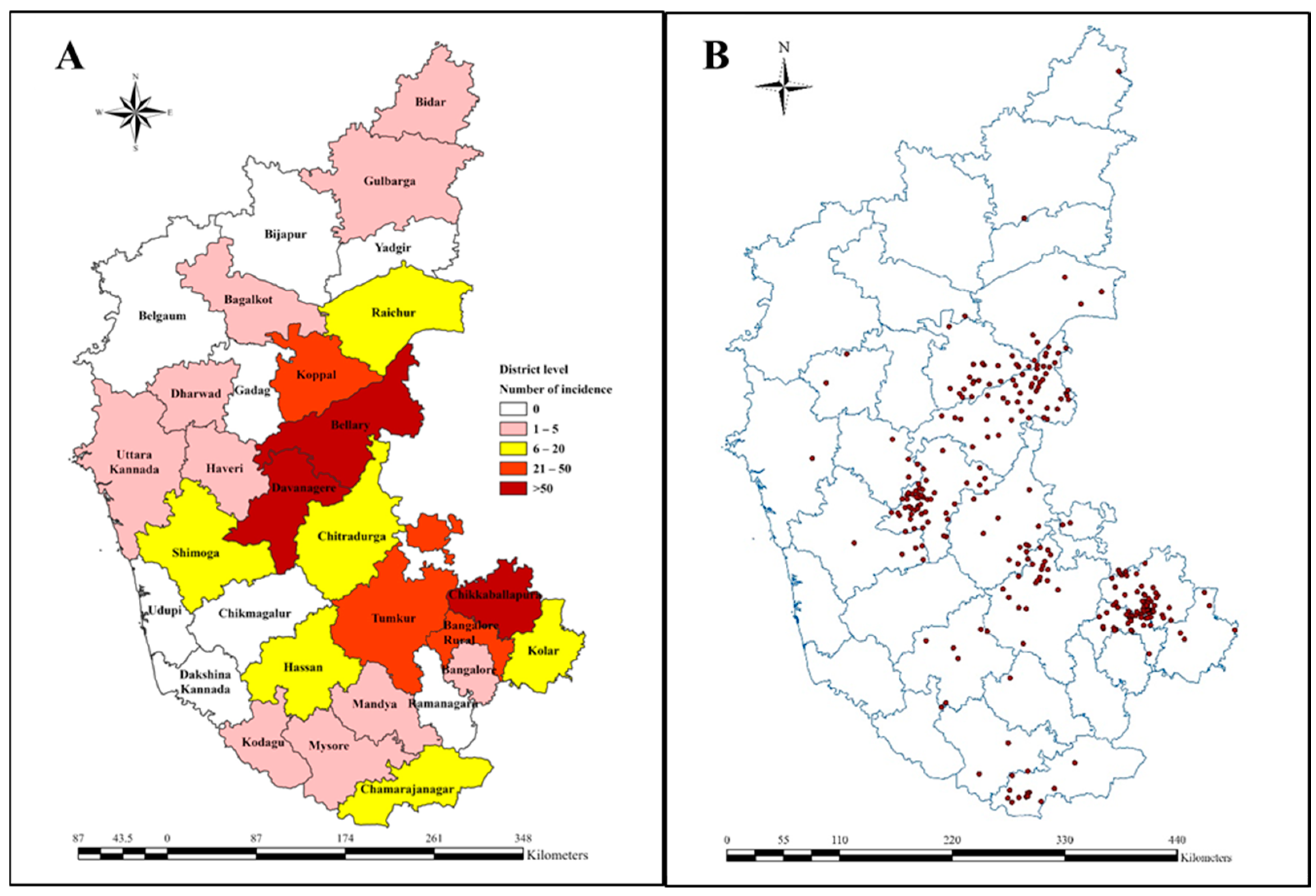
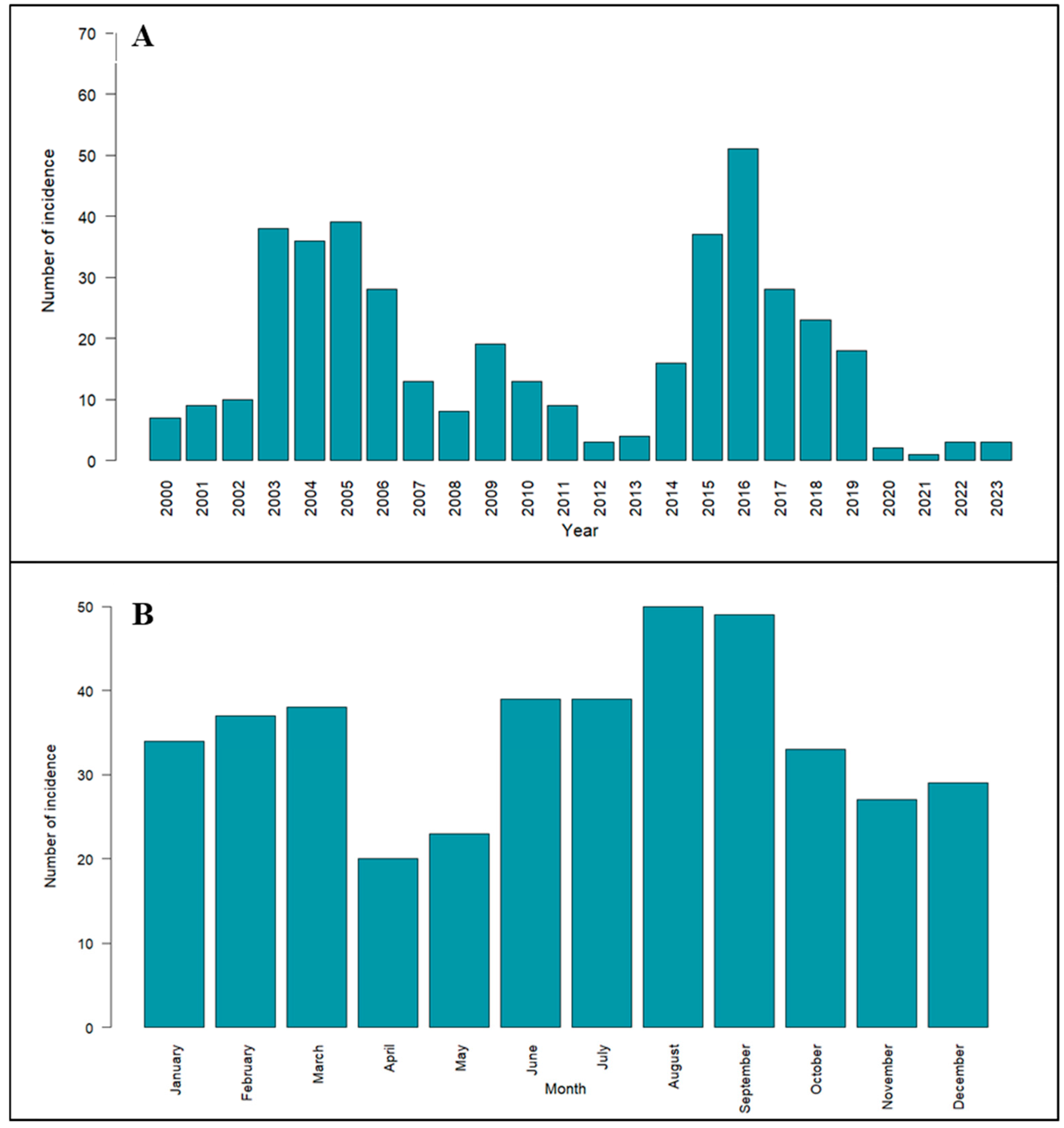
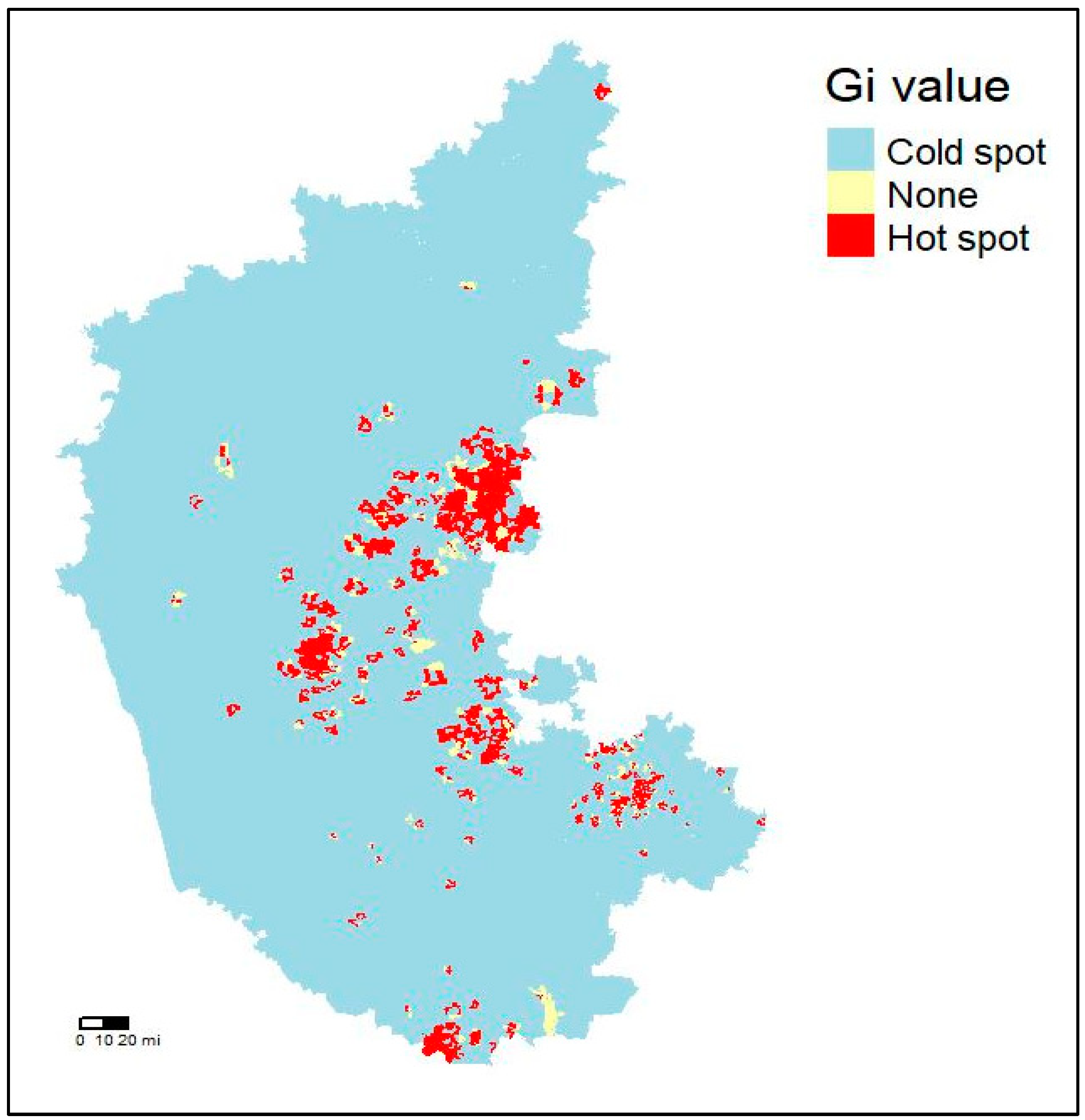

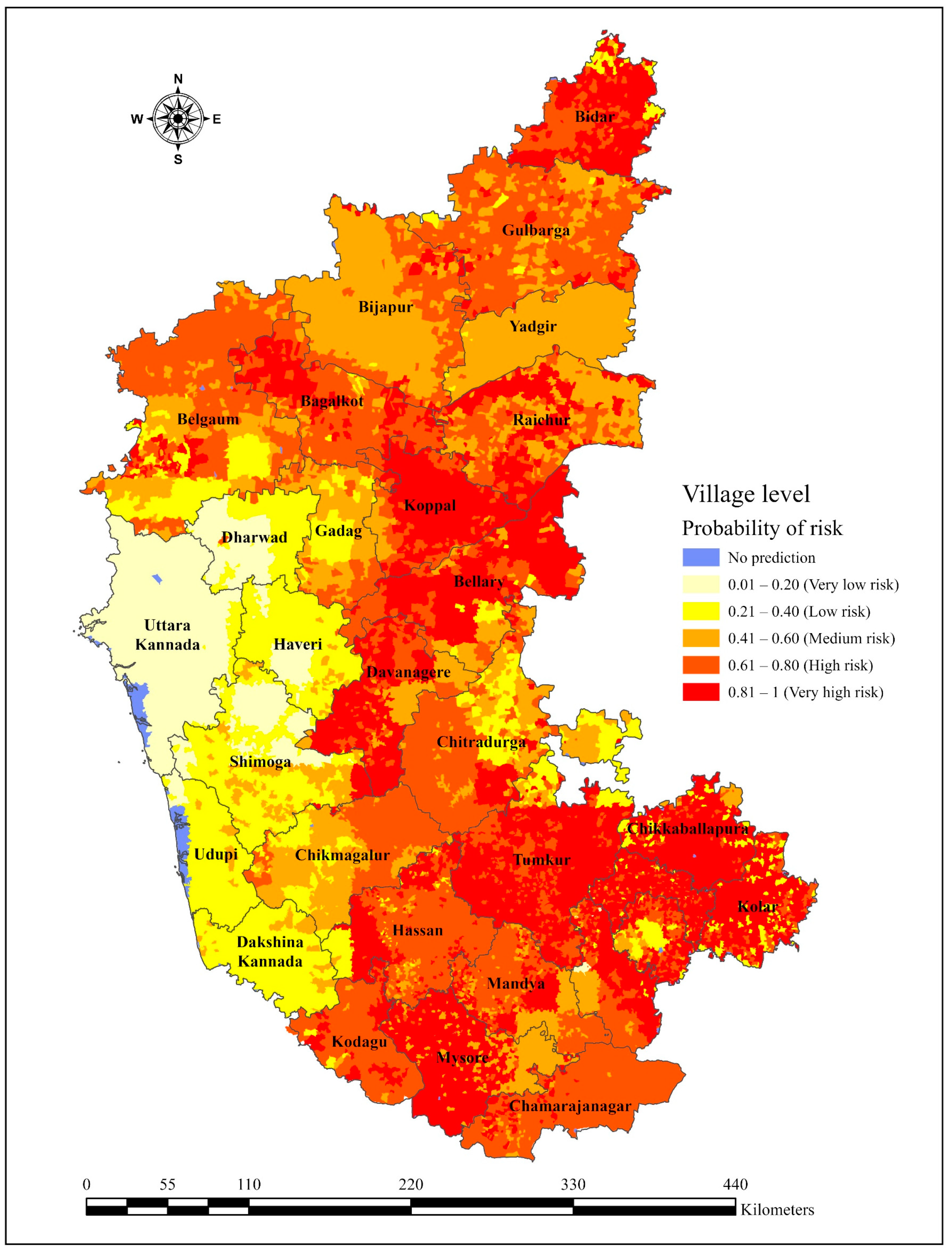

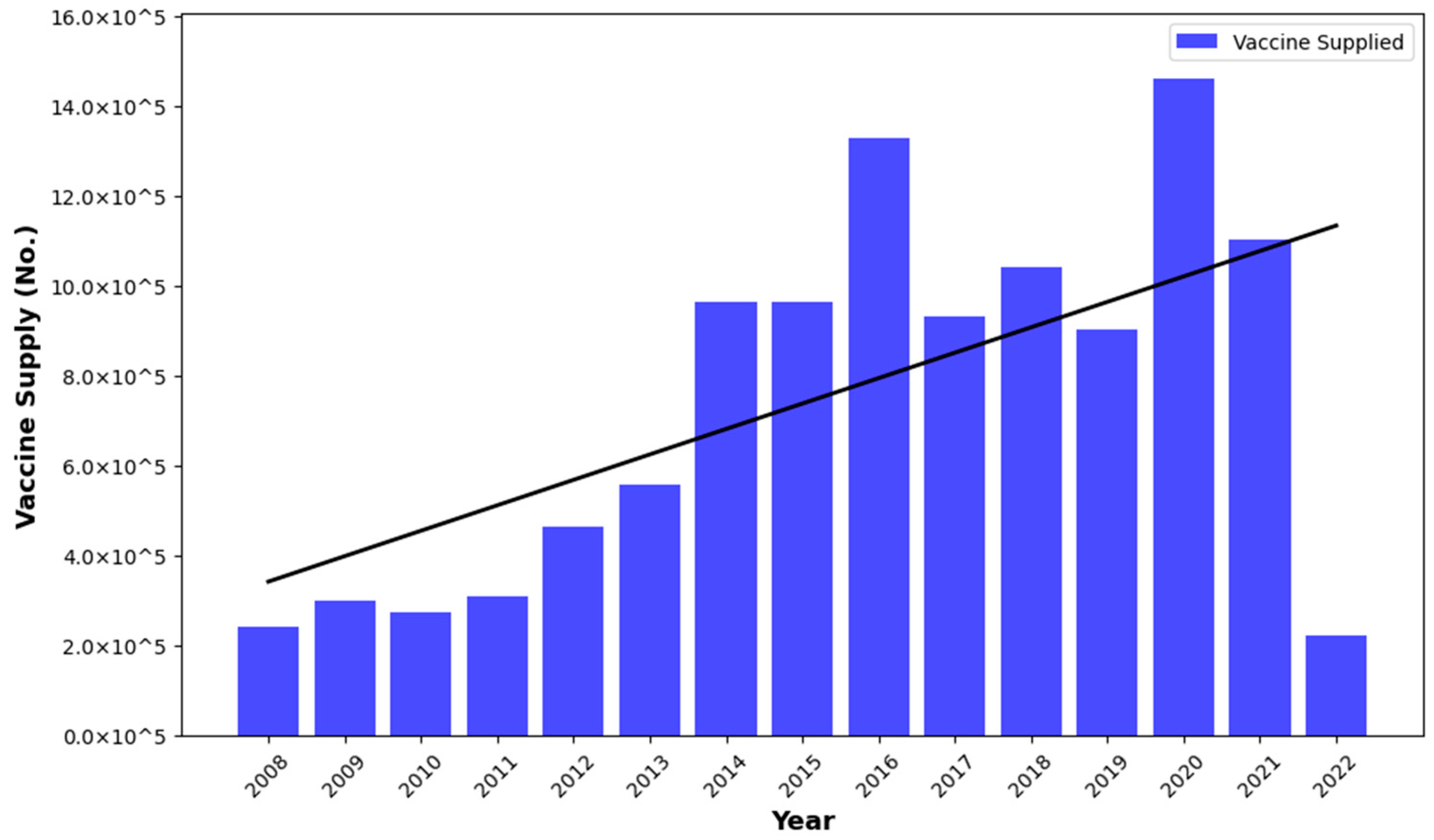
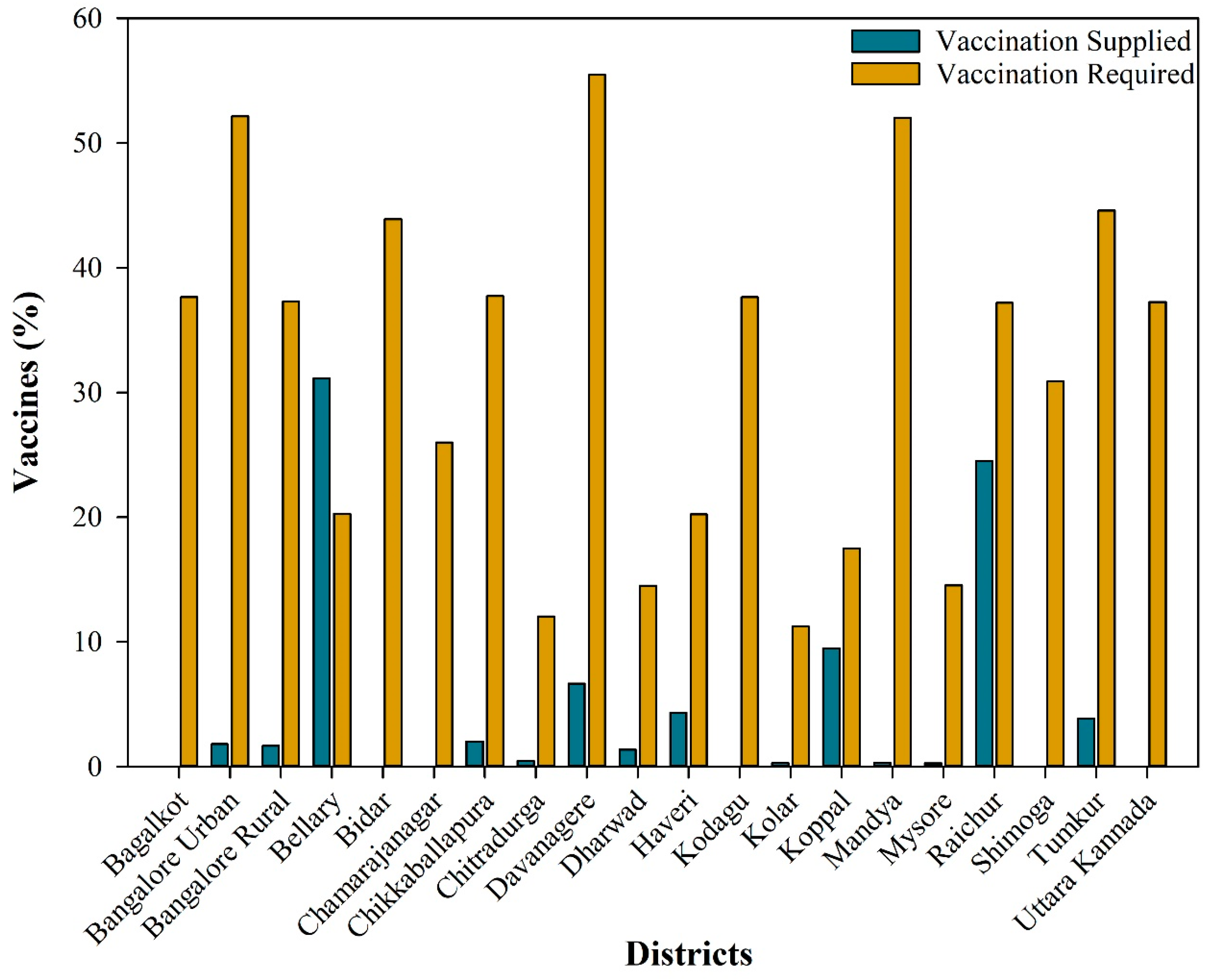
| Variable | Source | Units/Range | Attribute | Resolution |
|---|---|---|---|---|
| Meteorological parameters | ||||
| Air temperature | GLDAS version 2 https://ldas.gsfc.nasa.gov/gldas accessed on 20 May 2024 | k | netCDF | 0.25° × 0.25° |
| Potential evaporation rate | W/m2 | netCDF | 0.25° × 0.25° | |
| Rainfall precipitation rate | kg/m2/s | netCDF | 0.25° × 0.25° | |
| Specific humidity | kg/kg | netCDF | 0.25° × 0.25° | |
| Surface pressure | pa | netCDF | 0.25° × 0.25° | |
| Wind speed | m/s | netCDF | 0.25° × 0.25° | |
| Remote sensing parameters | ||||
| LST | MODIS https://ladsweb.modaps.eosdis.nasa.gov accessed on 21 May 2024 | °C | Raster | 1 km × 1 km |
| NDVI | −1 to 1 | Raster | 500 m × 500 m | |
| EVI | −1 to 1 | Raster | 500 m × 500 m | |
| PET | mm | Raster | 500 m × 500 m | |
| LAI | m2/m2 | Raster | 500 m × 500 m | |
| Soil parameters | ||||
| Soil temperature | NOAA https://www.psl.noaa.gov accessed on 20 May 2024 | k | netCDF | 1 km × 1 km |
| Soil moisture | GLDAS version 2 https://ldas.gsfc.nasa.gov/gldas accessed on 20 May 2024 | kg/m2 | netCDF | 0.25° × 0.25° |
| Soil pH | Karnataka soil health data (ICRISAT Development Centre, Government of Karnataka) https://doi.org/10.21421/D2/QYCEGR accessed on 22 May 2024 | Acidic < 6.5 Neutral 6.5–7.5 Alkaline > 7.5 | tab | NA |
| Organic carbon | % | tab | NA | |
| Electrical conductivity | ds/m | tab | NA | |
| Available potassium | ppm | tab | NA | |
| Available phosphorous | ppm | tab | NA | |
| Available zinc | ppm | tab | NA | |
| Available sulphur | ppm | tab | NA | |
| Available boron | ppm | tab | NA | |
| Geographical parameters | ||||
| Elevation | DIVA-GIS (https://diva-gis.org/ accessed on 22 May 2024) | m | Shape file | NA |
| Roadways | OpenStreetMap Data Extracts (https://download.geofabrik.de/asia/india.html accessed on 22 May 2024) | m | Shape file | NA |
| Waterbodies | m | Shape file | NA | |
| Waterways | m | Shape file | NA | |
| Cluster | Latitude | Longitude | Radius (km) | Time Frame | O | E | O/E | RR | LLR | p Value | |
|---|---|---|---|---|---|---|---|---|---|---|---|
| From | To | ||||||||||
| 1 | 13.42 | 77.53 | 31.89 | 1 January 2000 | 31 December 2016 | 81.00 | 19.87 | 4.08 | 4.82 | 57.64 | 0.001 |
| 2 | 13.27 | 77.82 | 34.67 | 1 January 2003 | 31 December 2019 | 76.00 | 18.69 | 4.07 | 4.75 | 53.62 | 0.001 |
| 3 | 13.59 | 77.84 | 33.99 | 1 January 2003 | 31 December 2016 | 68.00 | 18.85 | 3.61 | 4.11 | 41.24 | 0.001 |
| 4 | 12.24 | 76.57 | 159.94 | 1 January 2001 | 31 December 2019 | 58.00 | 15.02 | 3.86 | 4.32 | 37.75 | 0.001 |
| 5 | 14.04 | 76.02 | 45.55 | 1 January 2001 | 31 December 2017 | 38.00 | 8.05 | 4.72 | 5.09 | 30.15 | 0.001 |
| 6 | 13.98 | 75.22 | 67.42 | 1 January 2000 | 31 December 2018 | 32.00 | 7.18 | 4.46 | 4.74 | 23.76 | 0.001 |
| 7 | 14.82 | 76.25 | 52.98 | 1 January 2017 | 31 December 2017 | 12.00 | 1.28 | 9.39 | 9.64 | 16.29 | 0.001 |
| 8 | 15.86 | 76.05 | 0.00 | 1 January 2020 | 31 December 2021 | 1.00 | 17.22 | 0.06 | 0.06 | 13.70 | 0.004 |
| 9 | 14.53 | 75.85 | 11.20 | 1 January 2017 | 31 December 2017 | 4.00 | 0.06 | 63.23 | 63.83 | 12.67 | 0.005 |
| 10 | 14.67 | 75.77 | 7.51 | 1 January 2017 | 31 December 2017 | 5.00 | 0.18 | 28.03 | 28.36 | 11.87 | 0.009 |
| 11 | 13.92 | 76.92 | 7.47 | 1 January 2016 | 31 December 2018 | 2.00 | 17.72 | 0.11 | 0.11 | 11.66 | 0.01 |
| 12 | 14.13 | 76.83 | 20.50 | 1 January 2008 | 31 December 2018 | 1.00 | 14.98 | 0.07 | 0.07 | 11.51 | 0.01 |
| 13 | 15.42 | 76.81 | 5.78 | 1 January 2014 | 31 December 2015 | 3.00 | 19.68 | 0.15 | 0.15 | 11.38 | 0.011 |
| 14 | 13.96 | 76.75 | 11.44 | 1 January 2018 | 31 December 2018 | 1.00 | 14.33 | 0.07 | 0.07 | 10.88 | 0.019 |
| 15 | 15.21 | 76.76 | 0.00 | 1 January 2003 | 31 December 2015 | 3.00 | 0.04 | 73.38 | 73.90 | 9.94 | 0.046 |
| Variables | Mean | Min | Max | SD | F-Value | 95% CI | p-Value |
|---|---|---|---|---|---|---|---|
| Meteorological parameters | |||||||
| Air temperature | 24.16 | 18.70 | 35.06 | 3.06 | 5.11 | 24.01–24.31 | 0.024 |
| Potential evaporation rate | 237.27 | 81.06 | 503.32 | 81.62 | 0.81 | 233.28–241.26 | 0.37 |
| Rainfall precipitation rate | 0.0000341 | 8.06 × 10−9 | 2.10 × 10−4 | 3.20 × 10−5 | 1.41 | 3.25 × 10−5–3.56 × 10−5 | 0.24 |
| Specific humidity | 0.01 | 0.00 | 0.02 | 0.00 | 3.03 | 0.01–0.01 | 0.08 |
| Surface pressure | 93,422.48 | 89,580.16 | 100,800.28 | 1863.83 | 30.70 | 93,331.31–93,513.64 | 5.54 × 10−8 |
| Wind speed | 3.49 | 1.31 | 8.25 | 1.28 | 0.18 | 3.42–3.55 | 0.67 |
| Remote sensing parameters | |||||||
| LST | 33.34 | 22.13 | 49.85 | 4.86 | 11.50 | 33.10–33.59 | 0.001 |
| NDVI | 0.42 | 0.04 | 0.86 | 0.15 | 2.47 | 0.41–0.43 | 0.12 |
| EVI | 0.28 | 0.07 | 0.64 | 0.10 | 5.70 | 0.27–0.28 | 0.017 |
| PET | 1236.65 | 20.30 | 3276.50 | 1197.63 | 13.55 | 1178.07–1295.22 | 2.65 × 10−4 |
| LAI | 0.08 | 0.01 | 2.50 | 0.12 | 0.01 | 0.07–0.08 | 0.93 |
| Soil parameters | |||||||
| Soil temperature | 298.20 | 293.00 | 307.39 | 2.81 | 15.72 | 298.06–298.33 | 8.72 × 10−5 |
| Soil moisture | 24.99 | 8.78 | 39.94 | 6.82 | 12.84 | 24.65–25.32 | 3.82 × 10−4 |
| Soil pH | 7.40 | 4.90 | 9.90 | 0.92 | 31.53 | 7.35–7.44 | 3.73 × 10−8 |
| Organic carbon | 0.52 | 0.10 | 1.32 | 0.24 | 1.58 | 0.51–0.53 | 0.21 |
| Electrical conductivity | 0.29 | 0.07 | 14.70 | 1.06 | 0.02 | 0.24–0.34 | 0.88 |
| Available potassium | 133.52 | 18.00 | 653.00 | 90.75 | 106.32 | 129.09–137.96 | 3.23 × 10−22 |
| Available phosphorous | 9.61 | 0.20 | 92.00 | 13.39 | 3.00 | 8.96–10.27 | 0.08 |
| Available zinc | 15.10 | 1.20 | 256.60 | 24.63 | 26.94 | 13.89–16.30 | 0.70 |
| Available sulphur | 0.68 | 0.20 | 4.80 | 0.44 | 0.15 | 0.66–0.70 | 3.38 × 10−7 |
| Available boron | 0.73 | 0.06 | 2.40 | 0.45 | 12.26 | 0.71–0.76 | 0.001 |
| Geographical parameters | |||||||
| Elevation | 614.80 | −1.00 | 1810.00 | 5304.33 | 23.61 | 5296.38–5312.28 | 1.71 × 10−6 |
| Road ways | 13,927.74 | 9.00 | 113,867.00 | 16,235.13 | 0.15 | 13,133.66–14,721.83 | 0.70 |
| Waterbodies | 2079.39 | 0.00 | 10,171.00 | 2119.20 | 3.77 | 1975.74–2183.05 | 0.05 |
| Waterways | 3379.35 | 14.00 | 13,873.00 | 2892.72 | 18.35 | 3237.87–3520.84 | 2.32 × 10−5 |
| Models | Kappa | ROC | TSS | AUC | Accuracy | Precision | Sensitivity | Specificity | F1 Score | LOG LOSS | Error Rate | Gini Coefficient |
|---|---|---|---|---|---|---|---|---|---|---|---|---|
| GLM | 0.35 | 0.84 | 0.51 | 0.84 | 0.76 | 0.85 | 0.96 | 0.41 | 0.91 | 0.36 | 0.24 | 0.69 |
| GAM | 0.35 | 0.84 | 0.51 | 0.84 | 0.76 | 0.85 | 0.96 | 0.41 | 0.91 | 0.36 | 0.24 | 0.69 |
| RF | 0.68 | 1.00 | 0.98 | 1.00 | 0.99 | 0.98 | 1.00 | 0.93 | 0.99 | 0.12 | 0.01 | 1.00 |
| GBM | 0.46 | 0.95 | 0.79 | 0.95 | 0.90 | 0.92 | 0.99 | 0.68 | 0.95 | 0.25 | 0.10 | 0.90 |
| NNET | 0.00 | 0.50 | 0.00 | 0.50 | 0.22 | 0.50 | 0.00 | 0.00 | 1.00 | 5.07 | 0.78 | 1.00 |
| MARS | 0.43 | 0.92 | 0.67 | 0.92 | 0.84 | 0.89 | 0.97 | 0.59 | 0.93 | 0.29 | 0.16 | 0.83 |
| FDA | −0.01 | 0.50 | 0.00 | 0.50 | 0.78 | 0.78 | 1.00 | 0.00 | 0.88 | 7.64 | 0.22 | 0.99 |
| CT | 0.62 | 0.92 | 0.73 | 0.92 | 0.86 | 0.93 | 0.91 | 0.71 | 0.92 | 0.27 | 0.14 | 0.89 |
| SVM | 0.54 | 0.89 | 0.72 | 0.89 | 0.88 | 0.86 | 1.00 | 0.41 | 0.92 | 0.77 | 0.12 | 0.78 |
| NB | −0.35 | 0.85 | −0.09 | 0.85 | 0.20 | 0.11 | 0.01 | 0.79 | 0.01 | 7.03 | 0.80 | −0.70 |
| ADA | 0.79 | 0.87 | 0.75 | 0.87 | 0.93 | 0.94 | 0.98 | 0.76 | 0.96 | 2.28 | 0.07 | 0.99 |
Disclaimer/Publisher’s Note: The statements, opinions and data contained in all publications are solely those of the individual author(s) and contributor(s) and not of MDPI and/or the editor(s). MDPI and/or the editor(s) disclaim responsibility for any injury to people or property resulting from any ideas, methods, instructions or products referred to in the content. |
© 2024 by the authors. Licensee MDPI, Basel, Switzerland. This article is an open access article distributed under the terms and conditions of the Creative Commons Attribution (CC BY) license (https://creativecommons.org/licenses/by/4.0/).
Share and Cite
Anandakumar, J.; Suresh, K.P.; Patil, A.V.; Jagadeesh, C.A.; Bylaiah, S.; Patil, S.S.; Hemadri, D. Comprehensive Spatial-Temporal and Risk Factor Insights for Optimizing Livestock Anthrax Vaccination Strategies in Karnataka, India. Vaccines 2024, 12, 1081. https://doi.org/10.3390/vaccines12091081
Anandakumar J, Suresh KP, Patil AV, Jagadeesh CA, Bylaiah S, Patil SS, Hemadri D. Comprehensive Spatial-Temporal and Risk Factor Insights for Optimizing Livestock Anthrax Vaccination Strategies in Karnataka, India. Vaccines. 2024; 12(9):1081. https://doi.org/10.3390/vaccines12091081
Chicago/Turabian StyleAnandakumar, Jayashree, Kuralayanapalya Puttahonnappa Suresh, Archana Veeranagouda Patil, Chethan A. Jagadeesh, Sushma Bylaiah, Sharanagouda S. Patil, and Divakar Hemadri. 2024. "Comprehensive Spatial-Temporal and Risk Factor Insights for Optimizing Livestock Anthrax Vaccination Strategies in Karnataka, India" Vaccines 12, no. 9: 1081. https://doi.org/10.3390/vaccines12091081
APA StyleAnandakumar, J., Suresh, K. P., Patil, A. V., Jagadeesh, C. A., Bylaiah, S., Patil, S. S., & Hemadri, D. (2024). Comprehensive Spatial-Temporal and Risk Factor Insights for Optimizing Livestock Anthrax Vaccination Strategies in Karnataka, India. Vaccines, 12(9), 1081. https://doi.org/10.3390/vaccines12091081





